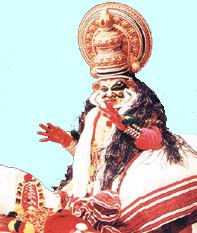 |
 4th April 1999 |
Front Page| |
India's Margi Troupe gave Colombo audiences a rare treat at the ElphinstoneEyes of anger and loveBy Shiromi PintoRed eyes flicker as hands sign anger and revenge in careful, silvered gestures. An isolated cheek muscle twitches, ruffling the smooth lacquer of red, green and beige faces.This is not a puppet show. This is Kathakali, where divine drama finds life in the gesture of fantastic marionettes.
Traditionally, only high caste Hindus, such as Brahmins, were admitted inside the temple where sacred storytelling took place.Low caste villagers were allowed only as far as the outer precincts of the temple where they were entertained with shadow puppet plays. Even then, the content of the koota and shadow puppet koota differed significantly so that the Krishnattam -eight stories based on the life of Krishna-was dramatised only inside the temple. The Krishnattam, a form of dance drama, is said to be the forerunner to Kathakali, and is still performed today. But it was one of the rajas of Kottarakkara who wrote the first Kathakali play. Based on the Ramayana, it consisted of eight stories performed over a period of six to eight hours. Though initially this form of dance drama was identified as Ramanattam, it was later known as Kathakali or 'story play'.With its opulent costumes, vivid make-up and complex hand and facial movements, Kathakali continues to thrill audiences, despite its intricate and somewhat alienating sign language. Today, Kathakali is performed throughout the world, and though it is principally a male art form, women too have entered the field. Greatly abridged and performed on stage rather than at temples, Kathakali has had to make artistic and religious compromises in the interests of its survival. After more than a 20 year absence, Kerala's Margi troupe returned to Sri Lanka, drawing audiences in Kandy and Colombo. Specialists in Kathakali and Koodiyattam (one of the only remaining forms of Sanskrit theatre), Margi has been around since 1974, performing and training students in these complex theatre art forms. Though it is supported by the Kerala State government and the government of India, as well as the Kendra Sangeet Nataka Academy, Margi is managed and run by volunteers. The all-male troupe performed Duryodhanavadhom, an excerpt from the epic Mahabharata written for Kathakali by Vayaskara Moosad. Actor Margi Vijayakumar, who specialises in female roles, mimed in elaborate detail Draupadi's humiliation at the hands of Dussasana, Kaurava prince. And as she related her disrobing by the evil Kauravas, the accompanying musicians sang her desperation and anger, completing the spell of appealing hands and twitching eyebrows. Krishna, whose noble nature is signified by bright green make-up, responded with comforting gestures and a benevolent gaze, reassuring Draupadi, wife of the five Pandava princes, that her sufferings would soon be avenged. The pace picked up in the following two scenes as Duryodhana and Dussasana entered the stage in classic Kathakali style. Clutching the brightly coloured curtain held before them, each let out monstrous shouts, pulling the cloth down at intervals to reveal a red face decorated with a fringed, paper visor: the marks of a villain. In spite of Krishna's appeals to Duryodhana to relinquish part of his kingdom to the banished Pandavas, the latter refused. As we know, the Mahabharata subsequently ends with a terrible battle between the Pandavas and the Kauravas, and part of this was dramatised in the final act. Here Bhima, one of the Pandava princes, kills Dussasana in a fit of rage, ripping his chest open and drinking his blood. Draupadi enters the scene and is horrified whereupon Bhima ties her hair with bloodied hands, thus restoring her honour. With such a dynamic and visceral story to tell, Margi succeeded in recreating some of the suspense and awe which must have moved audiences in a previous era. But Kathakali depends to a great extent on prior knowledge, and an understanding of the grammar which underlies what we see today as a largely incomprehensible sign language. And if the audience does not understand the language of the accompanying singing, then they are even more alienated. It is for this reason that Kathakali actors have ventured into a more contemporary realm, dramatising stories which are part of their target audience's experience. In England, one can find a Kathakali performance of Snow White. Margi too has engaged in cross-cultural performances. Recently the troupe participated in an international project which took them to Hong Kong, Europe and the United States. Such are the strategies resorted to by modern day Kathakali artistes. Still there is a feeling that the original intent and impact of Kathakali has been lost through the centuries. If the audience is moved-as it was by Margió despite all the obstacles, how much more gripping then in an earlier age? |
||
 |
Front Page| News/Comment| Editorial/Opinion| Business| Sports | Mirror Magazine |
|
 |
Please send your comments and suggestions on this web site to |
|
 Dating
back some three to four hundred years, Kathakali unites the Keralan traditions
of purakoota and akakoota (storytelling inside and outside the temple),
thus making Sanskrit drama accessible to more than just the village elite.
Dating
back some three to four hundred years, Kathakali unites the Keralan traditions
of purakoota and akakoota (storytelling inside and outside the temple),
thus making Sanskrit drama accessible to more than just the village elite.